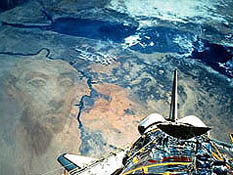|
An educational Forum based on new Ariticle # 3 Joseph and the Amarna Kings © Ahmed Osman 2001 |
Present
Version is WTheaux visited |
Overview and comments by
contributing |
|
WHO WAS JOSEPH? Since the start of archaeological digging in Egypt about a hundred years ago, scholars have been trying to answer this question: Who was the king who appointed Joseph as his minister, and during which period of Egyptian history did he live? Joseph is said in the Bible and the Quran, to have been sold as a slave into Egypt. It was his own brothers who handed him over to a trade caravan, as they became jealous when Jacob their father gave him a coat with many colours. An Egyptian nobleman bought the young Hebrew boy and made him overseer over his house, but when his mistress falsely accused him of trying to seduce her, Joseph was sent to prison. Two years later, Joseph was set free by Pharaoh who also appointed him as one of his ministers when he was able to interpret the king's dream. As the name of Pharaoh is not given in the holy books, scholars looked for some other details in the story of Joseph, to help them determine his time in history. They noticed that "chariots" were mentioned three times in the Book of Genesis: When he appointed him as his minister, Pharaoh gave Joseph a chariot; Joseph used a chariot to go out to welcome his father Jacob and the rest of the tribe of Israel when they arrived in Egypt; when the Israelites went to bury their father Jacob in Canaan, Joseph took with him "both chariots and horsemen." Early Egyptologists, however, were deceived when they attempted to fix Joseph's time in the light of this information. Until a decade or two ago, it was thought that the Hyksos kings who ruled Egypt for 108 years (before being removed by the18th dynasty) were the first to introduce the chariot into Egypt. As the Hyksos were themselves of Canaanite origin, it was easy to place Joseph the Hebrew during the period of their rule in Egypt. Nevertheless, all Hyksos sites at the eastern Nile Delta, as well as in Syria and Israel, have now been excavated, and no remains of chariots have been found in any one of them, neither any written or drawn reference to chariots. It is now generally accepted that the Egyptian kings of the 18th dynasty were the first to introduce the chariot. As Joseph the Patriarch was given a chariot by the king on his appointment, this indicates that he was responsible for the chariots. Here we find a link, for Yuya, a minister of Amenhotep III in the early part of the 14th century, was also responsible for the king's chariots. This is not all that Joseph and Yuya have in common; they both have a rare title in ancient Egypt: "Father to Pharaoh." When Joseph invited his brothers to have a meal at his house he, in an emotional moment, revealed to them his true identity. As they tried to apologize for what they had done to him he told them: "It was not you that sent me hither, but God: and made me father to Pharaoh." Yuya had the same title, "it nter n nb tawy," "the holy father of the lord of the two lands (Pharaoh)." The king also gave Joseph an Egyptian wife and an Egyptian name, the first element of which is "sef." Manetho, an Egyptian historian who wrote the history of his country to Ptolemy I during the 3rd century BC, mentions that Amenhotep III had a minister called Sef. It seems that the name "o-sef" or "Yo-sef" in Hebrew, and "Yu-sef" in Arabic, was composed of two elements: one being the Hebrew "Yu" which is short for Yahweh, and the other the Egyptian "sef." The tomb of Yuya was found in 1905, three years after Theodore M. Davis had obtained a concession to excavate in the Valley of the Kings. Davis provided the money, while the actual work was carried out by British archaeologists. There is a narrow side valley in the Valley of the Kings, about half a mile long, leading up to the mountain. Eight days before the Christmas of 1904, James Quibell started the examination of this side valley. A month later, he decided to transfer the men back to the mouth of the side valley, and by February 1 they had exposed the top of a sealed door that blocked the stairwell and, in a few days' time, Davis and his group were able to enter the tomb in which they found the sarcophagus of Yuya and his wife, Tuya, including their mummies. In the Book of Genesis, the last part of the Joseph story states that when Joseph died "they embalmed him, and he was put in a coffin in Egypt." One need only to look at the mummy of Yuya, now in the Cairo Museum, to be convinced that this is the mummy of Joseph. Ahmed Osman Historian, lecturer, researcher and author, Ahmed Osman is a British Egyptologist born in Cairo His four indepth books clarifying the history of the Bible and Egypt are: Stranger in the Valley of the Kings (1987) - Moses: Pharaoh of Egypt (1990) - The House of the Messiah (1992) - Out of Egypt (1998) |
|
|
|

